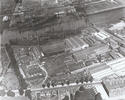 In 1830 there was only one shipbuilding yard in Glasgow, at Stobcross, building small wooden-hulled sailing vessels and steamships. Most of the marine engines made in Glasgow were installed in wooden hulls built in Port Glasgow or Greenock. In 1836 Tod & MacGregor opened their first yard, on the south bank of the river. It rapidly began specialising in building iron hulls, which proved so successful that other yards were set up to compete. The firm itself later moved down river to a larger yard at Meadowside.
In 1830 there was only one shipbuilding yard in Glasgow, at Stobcross, building small wooden-hulled sailing vessels and steamships. Most of the marine engines made in Glasgow were installed in wooden hulls built in Port Glasgow or Greenock. In 1836 Tod & MacGregor opened their first yard, on the south bank of the river. It rapidly began specialising in building iron hulls, which proved so successful that other yards were set up to compete. The firm itself later moved down river to a larger yard at Meadowside.
 The most influential of the new yards was Robert Napier's at Govan. All the subsequent shipyards in what eventually became Glasgow (apart from A & J Inglis' Pointhouse Yard) were in areas that stayed outside the city's jurisdiction until boundary extensions in 1912. The principal reason for this was the growing trade of Glasgow, which required quays for loading and unloading of goods to be extended over the sites of existing yards. The most important of the down-river yards was that of John Elder at Fairfield, which built the largest classes of passenger liners until the mid-1890s and also built warships. From about 1880 the use of steel allowed larger vessels to be built.
The most influential of the new yards was Robert Napier's at Govan. All the subsequent shipyards in what eventually became Glasgow (apart from A & J Inglis' Pointhouse Yard) were in areas that stayed outside the city's jurisdiction until boundary extensions in 1912. The principal reason for this was the growing trade of Glasgow, which required quays for loading and unloading of goods to be extended over the sites of existing yards. The most important of the down-river yards was that of John Elder at Fairfield, which built the largest classes of passenger liners until the mid-1890s and also built warships. From about 1880 the use of steel allowed larger vessels to be built.
 Other significant yards were Barclay, Curle & Co's Clydeholm Yard and A & J Stephen's Linthouse Yard, both of which built high-quality steamships. These two yards, and that of Charles Connell & Co, also made sailing vessels. A & J Inglis specialised in small paddle steamers, including many for the Firth of Clyde services. In 1907 Yarrow & Co moved their warship-building yard from the Thames to Scotstoun, a solid recognition that the Clyde by that time led the world in the efficient construction of vessels of the highest quality.
Other significant yards were Barclay, Curle & Co's Clydeholm Yard and A & J Stephen's Linthouse Yard, both of which built high-quality steamships. These two yards, and that of Charles Connell & Co, also made sailing vessels. A & J Inglis specialised in small paddle steamers, including many for the Firth of Clyde services. In 1907 Yarrow & Co moved their warship-building yard from the Thames to Scotstoun, a solid recognition that the Clyde by that time led the world in the efficient construction of vessels of the highest quality.